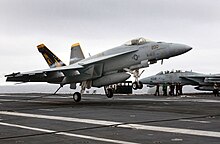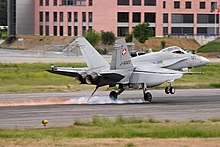Safety rope
Safeties (Engl. Arrestor cables or arrestor wires ) are at rope-proof systems used to aircraft decelerate over a short distance safely. The system is used on aircraft carriers with CATOBAR (Catapult Assisted Take Off But Arrested Recovery) and STOBAR (Short Take Off But Arrested Recovery) systems as well as on military runways as an emergency landing system.
Part of the emergency braking device on conventional elevator systems is also referred to as a safety rope .
history
With the very limited lengths of the flight decks of aircraft carriers, the question of braking the landing aircraft arose from the beginning of the first landings on carriers. The first attempts to catch a rope were made with ropes stretched across the landing area, with sandbags attached to the ends in order to slow down the landing aircraft, which grabbed the ropes with its catch hook , by the weight of the sandbags. These attempts proved unsuccessful and so brakes were installed on the wheels of the carrier aircraft, with which the pilot slowed down the aircraft on landing. This technology was sufficient for light aircraft in the early years of carrier aviation. However, with the further development of the aircraft, they became heavier and heavier and their landing speed increased, so that a new solution for braking the aircraft had to be found. Going back to the experiments with the safety ropes with sandbags, the safety ropes were now attached to pulleys, which unrolled further rope lengths when an aircraft caught the rope with its safety hook, and at the same time offered resistance to the moving mass of the landing aircraft in order to brake it. The first use of this safety rope technology took place on the British aircraft carrier HMS Courageous in June 1931. From then on, all aircraft carriers worldwide were equipped with this new technology.
Modern aircraft carriers
On aircraft carriers of the Nimitz class , up to four steel cables are stretched across the aft deck at a distance of 12 m and connected to a hydraulic system. The hydraulic system is adjusted according to the landing weight of the aircraft and ensures that the aircraft comes to a safe standstill by means of a counterforce.
The safety cables brake a 30 t aircraft from 240 km / h to 0 km / h in 2 seconds - the aircraft covers a distance of 96 m. Due to their enormous loads, the safety ropes are approved for a maximum of 100 landings. The entire capture system is designed for a service life of 54,000 landings.
Airport
At military airports , safety ropes are used to enable aircraft with brake failure or other technical defects to land safely. To do this, the rope is stretched over the runway at one end of the runway. The landing aircraft touches down in front of the safety rope, grabs it with its safety hook, as in the case of carrier landings, and is thereby braked. There are variants of these safety ropes that can be sunk flush into the runway surface from the tower so that small aircraft can roll over and land without problems. During unwinding, the safety rope activates a pump which exerts pressure on a disc brake on the spool in such a way that the (resulting) force building up in the rope decelerates the aircraft on the hook tolerably to a standstill. Finally, when the rope is stopped, the elastic stretching of the rope causes the aircraft to be pulled back briefly, thereby completely relaxing the rope. After the hook is released from the rope, it is quickly pulled back into position by a motor.
Accidents
In 2005, an F / A-18F SuperHornet of the VFA-102 Squadron Diamondbacks severed a lifeline while landing on the USS Kitty Hawk (CV63). The rope snapped back and injured some of the deck crews.


